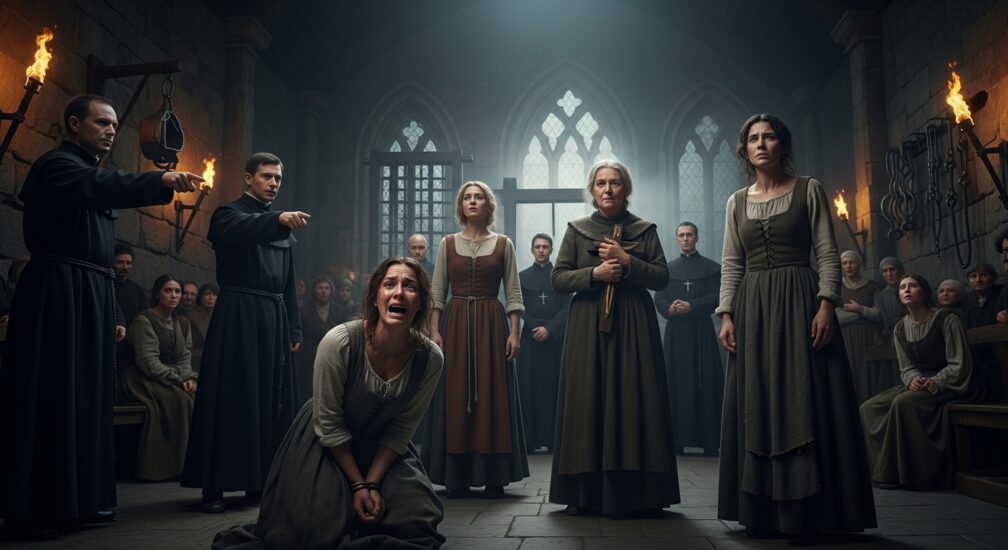The shadow of the hammer of witches loomed over Europe, marking a dark era in which suspicion and fear dictated life and death. From whispered rumors in villages to orchestrated trials led by inquisitors, the witch hunt history reveals a society gripped by paranoia, superstition, and the relentless pursuit of those accused of dark arts.
The Rise of Medieval Witch Trials
Medieval witch trials were not impluse activities, but developed into systematic events that took place under two very human, historically based influences: fear of witchcraft and institutional power. The target for the Inquisition witch trials were alleged practitioners of sorcery (often women, or others considered outsiders to one’s community) who were accused of witchcraft. There was prevalent mass hysteria and communities began to claim witchcraft for any moment of unexplained fortune – a failed crop or a sudden illness — it was presumably witchcraft.
Once accused, people in towns endured the torture of witch trial torture devices to extract confessions – stretching racks, iron collars – devices that became symbols of oppression in communities across modern-day Europe. There were even stories of execution of witches; burnings, hangings, drowning. These stories served as grim reminders of the power of the Inquisition and its connection to the Catholic Church’s role in witch trials
Fear and Mass Hysteria
The fear of witchcraft extended beyond individual villages. Entire regions experienced mass hysteria witch trials, where collective panic escalated accusations and fueled persecution of witches. Early modern authorities, aware of public unrest, sometimes encouraged the hunts, resulting in widespread chaos. The early modern witch hunts demonstrate the dangerous intersection of superstition, law, and mass psychology.
Communities were the scapegoats of their own anxieties, and subjects of minor trauma, such as divination, hexing, and the occult, were critiqued. Even the innocent things could be seen as maleficium or an indication of participation in diabolism. Covens, enchantments, and minor hexes were repurposed as crimes; a sign of a society obsessed with being in control, whether of the material or the immaterial world.
The Inquisition and Witchcraft
The link between the Inquisition and witchcraft is central to understanding this period. The spanish inquisition witch trials intensified scrutiny of suspected heretics, combining religious authority with judicial power. Inquisition and witchcraft accusations often relied on testimony extracted under duress, with inquisitors interpreting signs of blasphemy, superstition, or association with demons as proof of guilt.
These trials were marked by cunning and strategy on the part of both accusers and accused. Prisoners sometimes attempted outsmarting medieval torturers through deception, endurance, and exploiting procedural loopholes. Methods of survival ranged from subtle resistance to elaborate rituals, all while facing the constant threat of torture and death.
Legacy and Reflection
Studying these events today reveals not only the horrors of historical persecution but also the human capacity for resistance, courage, and even rebellion in oppressive systems. Museums like the Medieval Torture Museum in Los Angeles and the Medieval Torture Museum in St Augustine provide insight into the tools and tactics used during this dark era. For travelers and history enthusiasts, they offer cool things to do in Chicago for history lovers and immersive experiences that contextualize the past.
The artifacts of this era – amulets, talismans, and objects associated with witchcraft and divination – continue to signal a fascination with mystery along with a fear and resulting violence indicative of terrified societies. From prophecy to superstition, the helm of hysteria into persecution is a source of wonder and the history of the Inquisition, witch executions, and witch hunts remains a stark reminder that fear that cannot be controlled becomes mass hysteria, which transforms communities, corrupts justice, and takes lives. Today, we study these patterns to acknowledge those who suffered while also identifying importance to the historical development of social paranoia.For more insights and detailed accounts, explore the blog and plan visits to institutions preserving this history.






